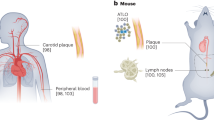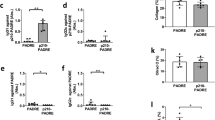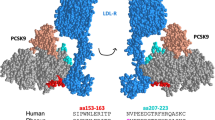Abstract
Experimental observations have established that the innate and adaptive immune mechanisms both have roles in the modulation of atherosclerosis. The complex function that the immune system has in the pathophysiology of atherosclerosis is highlighted by the fact that both proatherogenic and atheroprotective effects of immune activation can be demonstrated. An immune response to the protein and lipid components of oxidized LDL cholesterol has been observed in experimental models, and immunization with these antigens has generally reduced atherosclerosis. The findings suggest the tantalizing possibility that an atheroprotective vaccine can be developed. Our laboratories have identified several antigenic epitopes in the human apolipoprotein B100 component of LDL cholesterol. Active immunization with some of these epitopes has reduced atherosclerosis in hyperlipidemic mice. We believe, therefore, that a vaccine based on apolipoprotein B100-related peptide could have a role in reducing atherosclerosis. In this review, we discuss the possible immunologic mechanisms by which vaccines against atherosclerosis might work and the ways in which such treatment might be most effectively administered.
This is a preview of subscription content, access via your institution
Access options
Subscribe to this journal
Receive 12 print issues and online access
$209.00 per year
only $17.42 per issue
Buy this article
- Purchase on Springer Link
- Instant access to full article PDF
Prices may be subject to local taxes which are calculated during checkout


Similar content being viewed by others
References
Ross R (1999) Atherosclerosis—an inflammatory disease. N Engl J Med 340: 115–126
Shah PK (2003) Mechanisms of plaque vulnerability and rupture. J Am Coll Cardiol 41 (4 Suppl S): S15S–S22S
Binder CJ et al. (2002) Innate and acquired immunity in atherogenesis. Nat Med 8: 1218–1226
Hansson GK et al. (2002) Innate and adaptive immunity in the pathogenesis of atherosclerosis. Circ Res 91: 281–291
Nilsson J et al. (2005) Immunomodulation of atherosclerosis: implications for vaccine development. Arterioscler Thromb Vasc Biol 25: 18–28
Gordon S (2002) Pattern recognition receptors: doubling up for the innate immune response. Cell 111: 927–930
Xu XH et al. (2001) Toll-like receptor-4 is expressed by macrophages in murine and human lipid-rich atherosclerotic plaques and upregulated by oxidized LDL. Circulation 104: 3103–3108
Edfeldt K et al. (2002) Expression of toll-like receptors in human atherosclerotic lesions: a possible pathway for plaque activation. Circulation 105: 1158–1161
Michelsen KS et al. (2004) Lack of TLR4 or myeloid differentiation factor 88 reduces atherosclerosis and alters plaque phenotype in mice deficient in apolipoprotein E. Proc Natl Acad Sci USA 101: 10679–10684
Bjorkbacka H et al. (2004) Reduced atherosclerosis in MyD88-null mice links elevated serum cholesterol levels to activation of innate immunity signaling pathways. Nat Med 10: 416–421
Shaw PX et al. (2000) Natural antibodies with the T15 idiotype may act in atherosclerosis, apoptotic clearance, and protective immunity. J Clin Invest 105: 1731–1740
Binder CJ et al. (2003) Pneumococcal vaccination decreases atherosclerotic lesion formation: molecular mimicry between Streptococcus pneumoniae and oxidized LDL. Nat Med 9: 736–743
Binder CJ et al. (2005) The role of natural antibodies in atherogenesis. J Lipid Res 46: 1353–1363
Binder CJ et al. (2004) IL-5 links adaptive and natural immunity specific for epitopes of oxidized LDL and protects from atherosclerosis. J Clin Invest 114: 427–437
Neto JRF et al. (2004) Passive immunization with monoclonal (IgM) antibody to phosphorylcholine, an oxidized LDL related neoantigen, reduces accelerated atherosclerosis in a vein-graft model in apo E null mice [abstract]. Circulation 110: III–52
Buono C et al. (2002) Influence of C3 deficiency on atherosclerosis. Circulation 105: 3025–3031
Persson L et al. (2004) Lack of complement factor C3, but not factor B, increases hyperlipidemia and atherosclerosis in apolipoprotein E−/− Low-density Lipoprotein receptor−/− mice. Arterioscler Thromb Vasc Biol 24: 1062–1067
Constant SL and Bottomly K (1997) Induction of Th1 and Th2 CD4+ T cell responses: the alternative approaches. Annu Rev Immunol 15: 297–322
Frostegard J et al. (1999) Cytokine expression in advanced human atherosclerotic plaques: dominance of pro-inflammatory (Th1) and macrophage-stimulating cytokines. Atherosclerosis 145: 33–43
Zhou X et al. (1998) Hypercholesterolemia is associated with a T helper (Th) 1/Th2 switch of the autoimmune response in atherosclerotic apo E-knockout mice. J Clin Invest 101: 1717–1725
Zhou X et al. (2000) Transfer of CD4+ T cells aggravates atherosclerosis in immunodeficient apolipoprotein E knockout mice. Circulation 102: 2919–2922
Sakaguchi S (2000) Regulatory T cells: key controllers of immunologic self-tolerance. Cell 101: 455–458
Mallat Z et al. (2003) Induction of a regulatory T cell type 1 response reduces the development of atherosclerosis in apolipoprotein E-knockout mice. Circulation 108: 1232–1237
Pinderski Oslund LJ et al. (1999) Interleukin-10 blocks atherosclerotic events in vitro and in vivo. Arterioscler Thromb Vasc Biol 19: 2847–2853
Robertson AK et al. (2003) Disruption of TGF-β signaling in T cells accelerates atherosclerosis. J Clin Invest 112: 1342–1350
Tupin E et al. (2004) CD1d-dependent activation of NKT cells aggravates atherosclerosis. J Exp Med 199: 417–422
Frostegard J (2002) Autoimmunity, oxidized LDL and cardiovascular disease. Autoimmun Rev 1: 233–237
Tornvall P et al. (2003) Autoantibodies against modified low-density lipoproteins in coronary artery disease. Atherosclerosis 167: 347–353
Perschinka H et al. (2003) Cross-reactive B-cell epitopes of microbial and human heat shock protein 60/65 in atherosclerosis. Arterioscler Thromb Vasc Biol 23: 1060–1065
Xu Q et al. (1993) Association of serum antibodies to heat-shock protein 65 with carotid atherosclerosis. Lancet 341: 255–259
Stemme S et al. (1995) T lymphocytes from human atherosclerotic plaques recognize oxidized low density lipoprotein. Proc Natl Acad Sci USA 92: 3893–3897
Afek A et al. (2000). Immunization of low-density lipoprotein receptor deficient (LDL-RD) mice with heat shock protein 65 (HSP-65) promotes early atherosclerosis. J Autoimmun 14: 115–121
Xu Q et al. (1992). Induction of arteriosclerosis in normocholesterolemic rabbits by immunization with heat shock protein 65. Arterioscler Thromb 12: 789–799
George J et al. (1998) Induction of early atherosclerosis in LDL-receptor deficient mice immunized with β2 glycoprotein I. Circulation 11: 1108–1115
Palinski W et al. (1995) Immunization of low density lipoprotein (LDL) receptor-deficient rabbits with homologous malondialdehyde-modified LDL reduces atherogenesis. Proc Natl Acad Sci USA 92: 821–825
Ameli S et al. (1996) Effect of immunization with homologous LDL on early atherosclerosis in hypercholesterolemic rabbits. Arterioscler Thromb Vasc Biol 16: 1074–1079
Nilsson J et al. (1997) Immunization with homologous oxidized low density lipoprotein reduces neointimal formation after balloon in hypercholesterolemic rabbits. J Am Coll Cardiol 30: 1886–1891
Freigang S et al. (1998) Immunization of LDL receptor-deficient mice with homologous malondialdehyde-modified and native LDL reduces progression of atherosclerosis by mechanisms other than induction of high titers of antibodies to oxidative neoepitopes. Arterioscler Thromb Vasc Biol 18: 1972–1982
Zhou X et al. (2001) LDL immunization induces T-cell-dependent antibody formation and protection against atherosclerosis. Arterioscler Thromb Vasc Biol 21: 108–114
Chyu KY et al. (2004) Timing affects the efficacy of LDL immunization on atherosclerotic lesions in apo E (−/−) mice. Atherosclerosis 176: 27–35
Monsonego A and Weiner HL (2003) Immunotherapeutic approaches to Alzheimer's disease. Science 302: 834–838
Fong LG et al. (1987) Non enzymatic oxidative cleavage of peptide bonds in apoprotein B-100. J Lipid Res 12: 1466–1477
Hulthe J et al. (2001). Antibodies to oxidized LDL in relation to intima-media thickness in carotid and femoral arteries in 58-year-old subjectively clinically healthy men. Arterioscler Thromb Vasc Biol 21: 101–107
Fukumoto M et al. (2000) Antibodies against oxidized LDL and carotid artery intima-media thickness in a healthy population. Arterioscler Thromb Vasc Biol 20: 703–707
Hulthe J et al. (2001) Antibodies to oxidized LDL in relation to carotid atherosclerosis, cell adhesion molecules, and phospholipase A2 . Arterioscler Thromb Vasc Biol 21: 269–274
Palinski W and Witztum JL (2000) Immune responses to oxidative neoepitopes on LDL and phospholipids modulate the development of atherosclerosis. J Intern Med 247: 371–380
Fredrikson GN et al. (2003) Identification of immune responses against aldehyde-modified peptide sequences in ApoB associated with cardiovascular disease. Arterioscler Thromb Vasc Biol 23: 872–878
Fredrikson GN et al. (2003) inhibition of atherosclerosis in ApoE-null mice by immunization with ApoB-100 peptide sequences. Arterioscler Thromb Vasc Biol 23: 879–884
Reyes OS et al. (2002) Immunization with a novel human Apo B100 related peptide reduces atherosclerosis and inflammation in Apo E null mice. J Am Coll Cardiol 39 (Suppl A): S240A
Schipou A et al. (2004) Recombinant human antibodies against aldehyde-modified apolipoprotein B-100 peptide sequences inhibit atherosclerosis. Circulation 110: 2047–2052
Chen Y et al. (1995) Peripheral deletion of antigen-reactive T cells in oral tolerance. Nature 376: 177–180
Miller A et al. (1991) Antigen-driven bystander suppression following oral administration of antigens. J Exp Med 174: 791–798
Harats D et al. (2002) Oral tolerance with heat shock protein 65 attenuates Mycobacterium tuberculosis-induced and high-fat-diet-driven atherosclerotic lesions. J Am Coll Cardiol 40: 1333–1338
George J et al. (2004) Suppression of early atherosclerosis in LDL-receptor deficient mice by oral tolerance with β2-glycoprotein I. Cardiovasc Res 62: 603–609
Maron R et al. (2002) Mucosal administration of heat shock protein-65 decreases atherosclerosis and inflammation in aortic arch of low-density lipoprotein receptor-deficient mice. Circulation 106: 1708–1715
Davidson MH et al. (2003) The safety and immunogenicity of a CETP vaccine in healthy adults. Atherosclerosis 169: 113–120
Madjid M et al. (2003) Influenza and cardiovascular disease: a new opportunity for prevention and the need for further studies. Circulation 108: 2730–2736
Nichol KL et al. (2003) Influenza vaccination and reduction in hospitalizations for cardiac disease and stroke among the elderly. N Engl J Med 348: 1322–1332
Acknowledgements
We gratefully acknowledge the contributions of many colleagues in the Atherosclerosis Research Center at Cedars Sinai Medical Center and at the University of Lund to this work. We thank the Eisner Foundation, the Heart Fund, United Hostesses, and the Entertainment Industry Foundation for support. We used hybridoma technology provided by Dr Patricia Gearhart at the NIH in our work on this topic.
Author information
Authors and Affiliations
Corresponding author
Ethics declarations
Competing interests
PK Shah and J Nilsson are co-inventors and hold patents for peptide vaccines for atherosclerosis. By institutional patent the rights are assigned to Cedars-Sinai Medical Center, Los Angeles, CA, USA, and Lund University, Sweden, respectively.
Rights and permissions
About this article
Cite this article
Shah, P., Chyu, KY., Fredrikson, G. et al. Immunomodulation of atherosclerosis with a vaccine. Nat Rev Cardiol 2, 639–646 (2005). https://doi.org/10.1038/ncpcardio0372
Received:
Accepted:
Issue Date:
DOI: https://doi.org/10.1038/ncpcardio0372
This article is cited by
-
Inflammation and Plaque Vulnerability
Cardiovascular Drugs and Therapy (2009)
-
Vaccines for Cholesterol Management
World Journal of Surgery (2007)



